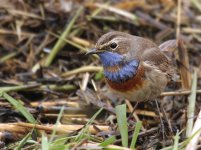Bluethroat Luscinia svecica
Nominate svecica (Linnaeus, 1758) (synonyms gaetkei, robusta), Scandinavia east through northern Siberia to western Alaska, south to c. 60°N in European USSR, to c. 57°N in western Siberia, to Altai and Sayan mountains in central Siberia, and to c. 55°N along shores of Sea of Okhotsk, also some isolated populations in mountains of central Europe; namnetum Mayaud, 1934, western France; cyanecula (Meisner, 1804), central Europe from eastern and northern France and Netherlands east to Carpathian basin, north-west Ukraine, Smolensk, and Leningrad (USSR), also Spain; volgae (Kleinschmidt, 1907), central European USSR from north-east Ukraine north to c. 57°N and east to middle Volga river, intergrading with cyanecula in west and with nominate svecica further north; pallidogularis (Zarudny, 1897) (synonyms saturatior, altaica), south-east European USSR (east from Volga) and lowland steppes of south-west Siberia south to Turkmeniya, east to foothills of Altai mountains and upper Yenisey, intergrading with volgae in west and with nominate svecica in north and east; magna (Zarudny and Loudon, 1904), Caucasus area, eastern Turkey, and Iran. Extralimital: tianschanica (Tugarinov, 1929), Pamir and Tien Shan mountains; 3 further races in central Asia and western Himalayas.
Geographical variation
Marked and complex; much individual variation locally, especially in apparent zones of secondary intergradation, such as central European USSR where cyanecula meets pallidogularis; also, clinal gradation from pallidogularis towards north and north-east into nominate svecica, towards south into tianschanica, and towards south-east into pale Mongolian races; large magna from Caucasus area, eastern Turkey, and Iran and small but long-billed race from western Himalayas are more isolated and distinct, though latter shows zone of apparently secondary intergradation into tianschanica in Kashmir and western Kun Lun mountains. L. s. cyanecula from Belgium and eastern France east to Carpathians and approximately to Smolensk, Novgorod, and Leningrad in western USSR is rather large, and ♂ has rounded silky-white spot or short bar on lower throat in breeding plumage, only rarely absent (see Plumages). L. s. namnetum from western France similar, but smaller in size (see Measurements). Birds from mountains of northern and central Spain (Witherby 1928; Ern 1966; Schmidt 1970) usually included in cyanecula, but in fact intermediate between this race and similarly isolated southern mountain race magna from Caucasus area or even nearer latter: large in size (see Measurements) and throat-spot often absent; of 7 ♂♂ examined, 2 had small white bar like cyanecula, 3 had limited amount of white concealed under blue, and 2 had no white at all (BMNH); of 17 birds seen in the field, 12 fully blue, 3 had white spot, and 2 a large reddish-buff spot (Corley Smith and Bernis 1956). L. s. magna from Caucasus and eastern Turkey to Iran large (see Measurements), throat of breeding ♂ entirely blue or with some concealed white, occasionally with small white spot; ♀ and non-breeding plumages inseparable from cyanecula, except for size. Birds east from Ukraine, Smolensk, Novgorod, and Leningrad through plains of USSR south of c. 60°N to Tien Shan, Mongolia, and west of Lake Baykal are generally smaller than populations further north and west; many races described from this area, differing only slightly in general colour, and situation not fully established (for contrasting opinions see, e.g., Kozlova 1945, Vaurie 1959, Stepanyan 1978a); of these southern birds, pallidogularis (synonyms saturatior, altaica) is a well-marked race, occurring from Volga and Turkmeniya east to Altai and upper Yenisey; breeding ♂ has lower cheeks, chin, and throat glossy pale cerulean-blue (much paler than in cyanecula) and spot on lower throat rufous-cinnamon, shaped as a large broad bar or broadly triangular spot; rufous breast-band rather narrow and pale; upperparts, sides of breast, and flanks paler brownish-grey, less drab-brown; ♀ and non-breeding plumages paler on upperparts and with narrower black malar stripe and narrower black band across upper chest. Area from Ukraine and central European USSR east to Volga, between ranges of pallidogularis and cyanecula, inhabited by highly variable volgae: throat of breeding ♂ deep blue and spot on lower throat small, like cyanecula, but spot rufous with narrow white border all round or on lower edge only, more rarely fully white or rufous (spot paler rufous and smaller than in nominate svecica); rufous breast-band rather narrow; ♀ and non-breeding plumages inseparable from cyanecula. Northern Eurasia and Alaska inhabited by nominate svecica, which intergrades with cyanecula, volgae, and pallidogularis within a zone from Leningrad eastwards along c. 60°N. Nominate svecica (synonyms gaetkei, robusta) characterized by large and rather triangular deep rufous throat-spot in breeding ♂ (not a narrower bar or more rounded spot as in most southern races); no constant difference from cyanecula in colour of upperparts or depth of blue on throat. ♀ and non-breeding plumages generally indistinguishable from cyanecula except sometimes when series of skins compared: malar stripe of ♀ cyanecula averages heavier and black band across upper chest broader than in ♀ nominate svecica (throat- spot either white or rufous in both races); adult ♂ non-breeding cyanecula has lower throat usually silky-white with narrow rufous feather-tips, nominate svecica more cream-white with slightly broader rufous tips. Isolated populations of red-spotted birds occur in mountains of central Europe within range of cyanecula (Krösche 1979; Vit 1979; Wartmann 1980; Müller 1982); these apparently glacial relicts of nominate svecica.







